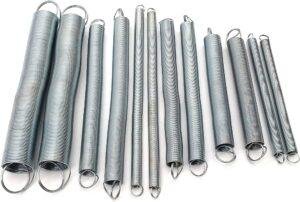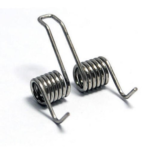Introduction:

When it comes to understanding the fundamental components of mechanical systems, it’s essential to grasp the concept of an extension spring. In this blog post, we’ll delve into the core definition of an extension spring and explore its multifaceted applications in various industries.
What is an Extension Spring?
An extension spring is a coiled, helical spring engineered to resist axial pulling forces. While compression springs handle compressive forces, extension springs perform the opposite task. They store mechanical energy when stretched or extended and release it when the force is removed, making them invaluable in countless applications.
Key Characteristics of Extension Springs:
- Helical Coil: Extension springs feature a helical coil shape, typically made from round wire. This design allows them to expand and contract while retaining their form.
- Hooks or Loops: Most extension springs come equipped with hooks or loops on both ends for easy attachment to other components or structures.
- Stress-Resistant: These springs are built to withstand a wide range of stress levels, ensuring their durability and longevity.
Applications of Extension Springs:
- Automotive Industry:
- Trunk and Hood Latches: Extension springs secure car trunks and hoods, keeping them tightly closed until manually opened.
- Suspension Systems: They aid in stabilizing vehicles by supporting their weight and providing shock absorption.
- Brake Systems: Extension springs play a pivotal role in brake mechanisms, facilitating effective engagement and disengagement.
- Aerospace:
- Retractable Landing Gear: Extension springs are vital in retractable landing gear systems, ensuring safe takeoffs and landings.
- Cargo Door Mechanisms: They assist in the smooth operation of cargo door systems, crucial for cargo aircraft.
- Parachute Deployment: Extension springs are used in parachute deployment systems, guaranteeing safe and controlled landings.
- Industrial Machinery:
- Agricultural Equipment: Extension springs maintain tension on belts and chains in machinery like plows and harvesters.
- Conveyor Systems: They ensure proper tension in conveyor belts, enhancing material transport efficiency.
- Garage Doors: Commonly found in garage door mechanisms, extension springs counterbalance the door’s weight.
- Consumer Goods:
- Exercise Equipment: Extension springs provide adjustable resistance in gym equipment like rowing machines and resistance bands.
- Toys: They power spring-loaded components and actions in various toys.
- Stationery: Extension springs enable the smooth operation of retractable pens and similar products.
- Medical Devices:
- Surgical Instruments: Extension springs are used in precision instruments for medical procedures.
- Prosthetics: They play a role in adjustable prosthetic devices.
- Hospital Beds: Extension springs are crucial for adjusting hospital bed positions, enhancing patient comfort.
Conclusion:
In summary, an extension spring is a coiled spring designed to resist axial pulling forces, making it an indispensable component in numerous industries. As technology advances, extension springs will continue to find innovative applications, emphasizing their significance in the world of engineering and manufacturing. Understanding what an extension spring is unlocks the door to a world of versatile mechanical solutions.
Related Posts

Suspension Springs-Learn more about Suspension Springs
marketing@microsprings.in contact us Suspension

Torsion Springs-Learn more about Torsion Springs
marketing@microsprings.in contact us Torsion Springs

Extension Spring-A Comprehensive Guide, Applications, Functions
marketing@microsprings.in contact us Extension Spring




